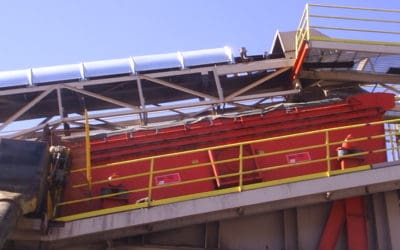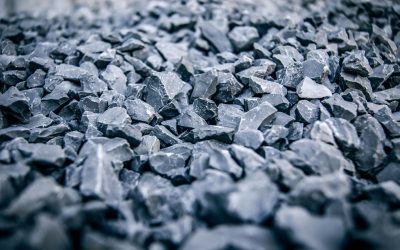Properly sizing a screen requires consideration of key material and machine characteristics, along with desired product specifications. The interplay of these factors will determine the proper machine for the application, the screen media and the efficiency of the machine. Mechanical screening is much more complicated than taking a single feed stream and making two piles.
Read on to learn more about mechanical screening and how material and operating characteristics impact screen efficiency.
View available screening equipment and systems for demanding applications from Aggregates Equipment, Inc. (AEI).
Why Do Materials Need to be Screened?
Processors screen materials for different reasons, often to:
- Produce a product with a desired particle distribution or characteristics
- Split a feed stream to separate processing lines
- Remove fines
- Remove finished product prior to an additional reduction step
Screening is often given a cursory glance in a process, but it can have a great effect on the capacity of a system and the quality of your products. Often the screen is one of the least expensive pieces of your system, while having an outsized impact on your profits.
Many applications utilize mechanical screening processes for the reasons mentioned above. Below are some of the most common screening applications.
Process control in aggregates and mining
Screens serve as a process control to protect process equipment, possibly a boiler for power generation, or to maintain the finished characteristics of a product such as asphalt or concrete.
Means to split feed stream in recycling and waste
Screening is often used as a means to split the feed stream between separate processing lines. Because of limitations in downstream sorting capacity, whether manual (picking stations) or mechanical (sensor sorters or magnetic separators), multiple processing lines are often required to handle the volume of the feed stream
Plant maintenance and cleanliness
Fine material can be removed from the process and treated separately, greatly reducing maintenance concerns throughout the plant. Fines collect in other machinery, creating health and explosion hazards and ferrous fines create problems in magnetic sortation processes.
Operating cost reduction and increased capacity
There is often a fraction of raw material that is already properly sized. In a size reduction process such as crushing, grinding, shredding or shearing, feeding finished product unnecessarily into a reducer creates avoidable wear and power consumption. Size reduction machines are often the most expensive wear related operating cost in a plant, as well as the largest consumers of power. Pre-screening the material or scalping reduces unnecessary operating costs and increases plant capacity.
If your operation needs efficiency screening, AEI offers industry leading materials screening solutions
What is mechanical screening, and how does it work?
Mechanical screening is the probability of a particle of a given size passing through an opening of a given size. As the size of the particle approaches the size of the opening, the probability of passing that particle through the screen decreases. Conversely, as the particle size decreases and the screen opening increases, the probability of passing the particle increases. Each opening in a screen presents an additional chance for a given particle to pass through. The more openings a particle is presented with, the higher the probability of passing that particle.
In real-world screening, this is witnessed through the particle distribution of the fines product and the coarse product. 100% efficiency does not happen in practice. Screening efficiency is defined as the ratio of the material that should pass through a given opening and the material that actually passed through that opening. In practice, the product distributions will be shaped like a curve. Fine particles pass the quickest with the highest efficiency, while near size particles have reduced efficiency.
When feeding a given distribution of material to a screening machine, there are three main steps to screening performed on a single screen deck.
- Bed stratification: The activation and agitation of the material through the screen motion or the movement of the material.
- Crowded screening: This section the smaller particles are in contact with the screen media and begin to pass in volume.
- Separated screening: In this section, the majority of the undersize material is already removed and the near size material has the opportunity to pass.
Material Characteristics of Screening Equipment
By increasing the screen length, you can increase screen efficiency by providing a longer time and probability for near size material to pass through the screen media.
Every application and material presents a unique challenge for a particular screen. Even the same material at a different location will not have exactly the same characteristics.
Particle Size Distribution
The particle distribution describes the sizes of the discrete particles in any feed stream. The percentage of material at each size will determine the capacity of a given machine. Key factors include the percentage passing the chosen sizing point; the more material required to pass through a screen, the larger the required screen area for the duty. The top-size of the material will also have a direct impact on the material’s screening.
Moisture
There are two types of moisture: surface and inherent. Inherent moisture is the moisture present inside of a material. Surface moisture is the moisture that is coating the exterior of a particle. Surface moisture has the greatest impact on the screening performance of a material.
Particle Shape
The particle shape in both the feed stream and the desired products affects the screen selection for the application, and understanding the type of particle is critical.
Density
Density of the material helps to describe the load and bulk the screening machine must convey. Conveying volume and maintaining effective bed depth are keys to handling low-density materials.
Operating Characteristics
When choosing a machine for a screening application, there are also important operating characteristics that must be considered. These may be present in an existing system or can be incorporated into the design of a system.
Feed Rate
Regular, consistent feed is critical to the proper operation of a screen. Irregular feed will result in the passage of oversize material when the screen load is running at its minimum, or result in carryover of fines when the load is at its maximum.
Bed Depth
The depth of the material on the screen affects the ability of the screen to stratify the material and allow the fines to pass through the deck; this is called bed depth.
Screen Openings
When choosing the opening of a screening surface, there is the nominal size of the screening mesh and the effective size of the mesh. Because of crowding of particles on the screening surface, there is a reduced probability of near size particles passing through the mesh. The nominal size of the mesh is the actual diameter of the opening on the deck. The effective size is the size of the product that the mesh produces. In a given application, the chosen nominal mesh size will produce an effective product size smaller than the nominal size.
The design of the openings on the screen surface helps to determine the efficiency of the machine, the capacity of the machine and the quality of the product. Open area on a screen, the ratio between the area of the holes and the screen surface, helps to determine the screen capacity. By decreasing the space between holes, webbing or wire diameter, the open area may be increased, increasing capacity.
Efficient screening is the quickest return on investment within your plant. Although outshined by processes that physically transform a material stream such as size reduction or color sortation, proper screening optimizes all these processing steps. Because the effect of screening is less observable, it is often overlooked. Do so at your own detriment.
To learn more about mechanical screening processes and equipment, contact AEI with specific questions about your processes or topics that you would like to investigate further. You can also email us at [email protected] or call (717)-656-2131.
Below is a list of references used in compilation of this blog and for additional reading on the topic:
Kelley, Errol and David J. Spottiswood, Mineral Processing Short Course, Colorado School of Mines, June 2012
Kelley and Spottiswood, Indroduction to Mineral Processing, Denver: John Wiley & Sons, 1989.
Vibrating Screen Manufactures Association, Vibrating Screen Handbook, Stamford, 1980.
Korte, DJ, Dry Screening Tests Conducted with BIVITEC® Screen, South Africa: Coal Tech, 2008.
Aggregates Equipment Inc, BIVITEC® Operations and Maintenance Manual, Leola, PA: 2012.


